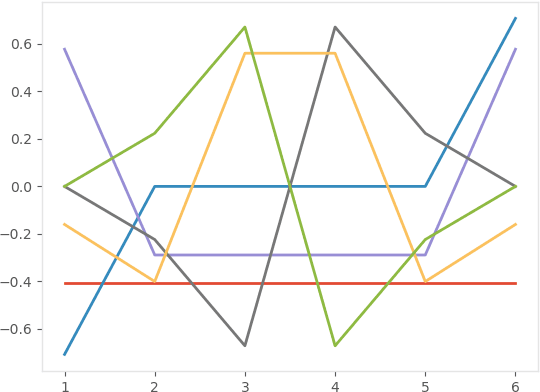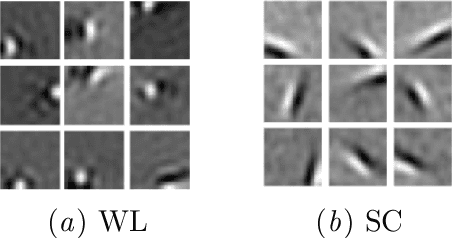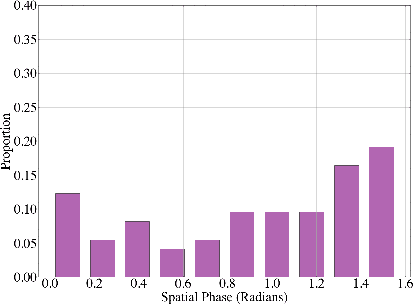Abiy Tasissa
Riemannian Optimization for Distance Geometry: A Study of Convergence, Robustness, and Incoherence
Jul 31, 2025Abstract:The problem of recovering a configuration of points from partial pairwise distances, referred to as the Euclidean Distance Geometry (EDG) problem, arises in a broad range of applications, including sensor network localization, molecular conformation, and manifold learning. In this paper, we propose a Riemannian optimization framework for solving the EDG problem by formulating it as a low-rank matrix completion task over the space of positive semi-definite Gram matrices. The available distance measurements are encoded as expansion coefficients in a non-orthogonal basis, and optimization over the Gram matrix implicitly enforces geometric consistency through the triangle inequality, a structure inherited from classical multidimensional scaling. Under a Bernoulli sampling model for observed distances, we prove that Riemannian gradient descent on the manifold of rank-$r$ matrices locally converges linearly with high probability when the sampling probability satisfies $p \geq \mathcal{O}(\nu^2 r^2 \log(n)/n)$, where $\nu$ is an EDG-specific incoherence parameter. Furthermore, we provide an initialization candidate using a one-step hard thresholding procedure that yields convergence, provided the sampling probability satisfies $p \geq \mathcal{O}(\nu r^{3/2} \log^{3/4}(n)/n^{1/4})$. A key technical contribution of this work is the analysis of a symmetric linear operator arising from a dual basis expansion in the non-orthogonal basis, which requires a novel application of the Hanson--Wright inequality to establish an optimal restricted isometry property in the presence of coupled terms. Empirical evaluations on synthetic data demonstrate that our algorithm achieves competitive performance relative to state-of-the-art methods. Moreover, we propose a novel notion of matrix incoherence tailored to the EDG setting and provide robustness guarantees for our method.
A Dual Basis Approach for Structured Robust Euclidean Distance Geometry
May 23, 2025Abstract:Euclidean Distance Matrix (EDM), which consists of pairwise squared Euclidean distances of a given point configuration, finds many applications in modern machine learning. This paper considers the setting where only a set of anchor nodes is used to collect the distances between themselves and the rest. In the presence of potential outliers, it results in a structured partial observation on EDM with partial corruptions. Note that an EDM can be connected to a positive semi-definite Gram matrix via a non-orthogonal dual basis. Inspired by recent development of non-orthogonal dual basis in optimization, we propose a novel algorithmic framework, dubbed Robust Euclidean Distance Geometry via Dual Basis (RoDEoDB), for recovering the Euclidean distance geometry, i.e., the underlying point configuration. The exact recovery guarantees have been established in terms of both the Gram matrix and point configuration, under some mild conditions. Empirical experiments show superior performance of RoDEoDB on sensor localization and molecular conformation datasets.
Structured Sampling for Robust Euclidean Distance Geometry
Dec 14, 2024Abstract:This paper addresses the problem of estimating the positions of points from distance measurements corrupted by sparse outliers. Specifically, we consider a setting with two types of nodes: anchor nodes, for which exact distances to each other are known, and target nodes, for which complete but corrupted distance measurements to the anchors are available. To tackle this problem, we propose a novel algorithm powered by Nystr\"om method and robust principal component analysis. Our method is computationally efficient as it processes only a localized subset of the distance matrix and does not require distance measurements between target nodes. Empirical evaluations on synthetic datasets, designed to mimic sensor localization, and on molecular experiments, demonstrate that our algorithm achieves accurate recovery with a modest number of anchors, even in the presence of high levels of sparse outliers.
Sample-Efficient Geometry Reconstruction from Euclidean Distances using Non-Convex Optimization
Oct 22, 2024



Abstract:The problem of finding suitable point embedding or geometric configurations given only Euclidean distance information of point pairs arises both as a core task and as a sub-problem in a variety of machine learning applications. In this paper, we aim to solve this problem given a minimal number of distance samples. To this end, we leverage continuous and non-convex rank minimization formulations of the problem and establish a local convergence guarantee for a variant of iteratively reweighted least squares (IRLS), which applies if a minimal random set of observed distances is provided. As a technical tool, we establish a restricted isometry property (RIP) restricted to a tangent space of the manifold of symmetric rank-$r$ matrices given random Euclidean distance measurements, which might be of independent interest for the analysis of other non-convex approaches. Furthermore, we assess data efficiency, scalability and generalizability of different reconstruction algorithms through numerical experiments with simulated data as well as real-world data, demonstrating the proposed algorithm's ability to identify the underlying geometry from fewer distance samples compared to the state-of-the-art.
Riemannian Optimization for Non-convex Euclidean Distance Geometry with Global Recovery Guarantees
Oct 08, 2024Abstract:The problem of determining the configuration of points from partial distance information, known as the Euclidean Distance Geometry (EDG) problem, is fundamental to many tasks in the applied sciences. In this paper, we propose two algorithms grounded in the Riemannian optimization framework to address the EDG problem. Our approach formulates the problem as a low-rank matrix completion task over the Gram matrix, using partial measurements represented as expansion coefficients of the Gram matrix in a non-orthogonal basis. For the first algorithm, under a uniform sampling with replacement model for the observed distance entries, we demonstrate that, with high probability, a Riemannian gradient-like algorithm on the manifold of rank-$r$ matrices converges linearly to the true solution, given initialization via a one-step hard thresholding. This holds provided the number of samples, $m$, satisfies $m \geq \mathcal{O}(n^{7/4}r^2 \log(n))$. With a more refined initialization, achieved through resampled Riemannian gradient-like descent, we further improve this bound to $m \geq \mathcal{O}(nr^2 \log(n))$. Our analysis for the first algorithm leverages a non-self-adjoint operator and depends on deriving eigenvalue bounds for an inner product matrix of restricted basis matrices, leveraging sparsity properties for tighter guarantees than previously established. The second algorithm introduces a self-adjoint surrogate for the sampling operator. This algorithm demonstrates strong numerical performance on both synthetic and real data. Furthermore, we show that optimizing over manifolds of higher-than-rank-$r$ matrices yields superior numerical results, consistent with recent literature on overparameterization in the EDG problem.
Locality Regularized Reconstruction: Structured Sparsity and Delaunay Triangulations
May 01, 2024Abstract:Linear representation learning is widely studied due to its conceptual simplicity and empirical utility in tasks such as compression, classification, and feature extraction. Given a set of points $[\mathbf{x}_1, \mathbf{x}_2, \ldots, \mathbf{x}_n] = \mathbf{X} \in \mathbb{R}^{d \times n}$ and a vector $\mathbf{y} \in \mathbb{R}^d$, the goal is to find coefficients $\mathbf{w} \in \mathbb{R}^n$ so that $\mathbf{X} \mathbf{w} \approx \mathbf{y}$, subject to some desired structure on $\mathbf{w}$. In this work we seek $\mathbf{w}$ that forms a local reconstruction of $\mathbf{y}$ by solving a regularized least squares regression problem. We obtain local solutions through a locality function that promotes the use of columns of $\mathbf{X}$ that are close to $\mathbf{y}$ when used as a regularization term. We prove that, for all levels of regularization and under a mild condition that the columns of $\mathbf{X}$ have a unique Delaunay triangulation, the optimal coefficients' number of non-zero entries is upper bounded by $d+1$, thereby providing local sparse solutions when $d \ll n$. Under the same condition we also show that for any $\mathbf{y}$ contained in the convex hull of $\mathbf{X}$ there exists a regime of regularization parameter such that the optimal coefficients are supported on the vertices of the Delaunay simplex containing $\mathbf{y}$. This provides an interpretation of the sparsity as having structure obtained implicitly from the Delaunay triangulation of $\mathbf{X}$. We demonstrate that our locality regularized problem can be solved in comparable time to other methods that identify the containing Delaunay simplex.
A Nyström method with missing distances
Nov 29, 2023Abstract:We study the problem of determining the configuration of $n$ points, referred to as mobile nodes, by utilizing pairwise distances to $m$ fixed points known as anchor nodes. In the standard setting, we have information about the distances between anchors (anchor-anchor) and between anchors and mobile nodes (anchor-mobile), but the distances between mobile nodes (mobile-mobile) are not known. For this setup, the Nystr\"om method is a viable technique for estimating the positions of the mobile nodes. This study focuses on the setting where the anchor-mobile block of the distance matrix contains only partial distance information. First, we establish a relationship between the columns of the anchor-mobile block in the distance matrix and the columns of the corresponding block in the Gram matrix via a graph Laplacian. Exploiting this connection, we introduce a novel sampling model that frames the position estimation problem as low-rank recovery of an inner product matrix, given a subset of its expansion coefficients in a special non-orthogonal basis. This basis and its dual basis--the central elements of our model--are explicitly derived. Our analysis is grounded in a specific centering of the points that is unique to the Nystr\"om method. With this in mind, we extend previous work in Euclidean distance geometry by providing a general dual basis approach for points centered anywhere.
A dual basis approach to multidimensional scaling: spectral analysis and graph regularity
Mar 10, 2023
Abstract:Classical multidimensional scaling (CMDS) is a technique that aims to embed a set of objects in a Euclidean space given their pairwise Euclidean distance matrix. The main part of CMDS is based on double centering a squared distance matrix and employing a truncated eigendecomposition to recover the point coordinates. A central result in CMDS connects the squared Euclidean matrix to a Gram matrix derived from the set of points. In this paper, we study a dual basis approach to classical multidimensional scaling. We give an explicit formula for the dual basis and fully characterize the spectrum of an essential matrix in the dual basis framework. We make connections to a related problem in metric nearness.
Sparse, Geometric Autoencoder Models of V1
Feb 22, 2023



Abstract:The classical sparse coding model represents visual stimuli as a linear combination of a handful of learned basis functions that are Gabor-like when trained on natural image data. However, the Gabor-like filters learned by classical sparse coding far overpredict well-tuned simple cell receptive field (SCRF) profiles. A number of subsequent models have either discarded the sparse dictionary learning framework entirely or have yet to take advantage of the surge in unrolled, neural dictionary learning architectures. A key missing theme of these updates is a stronger notion of \emph{structured sparsity}. We propose an autoencoder architecture whose latent representations are implicitly, locally organized for spectral clustering, which begets artificial neurons better matched to observed primate data. The weighted-$\ell_1$ (WL) constraint in the autoencoder objective function maintains core ideas of the sparse coding framework, yet also offers a promising path to describe the differentiation of receptive fields in terms of a discriminative hierarchy in future work.
Alternating minimization algorithm with initialization analysis for r-local and k-sparse unlabeled sensing
Nov 14, 2022Abstract:The unlabeled sensing problem is to recover an unknown signal from permuted linear measurements. We propose an alternating minimization algorithm with a suitable initialization for the widely considered k-sparse permutation model. Assuming either a Gaussian measurement matrix or a sub-Gaussian signal, we upper bound the initialization error for the r-local and k-sparse permutation models in terms of the block size $r$ and the number of shuffles k, respectively. Our algorithm is computationally scalable and, compared to baseline methods, achieves superior performance on real and synthetic datasets.
 Add to Chrome
Add to Chrome Add to Firefox
Add to Firefox Add to Edge
Add to Edge